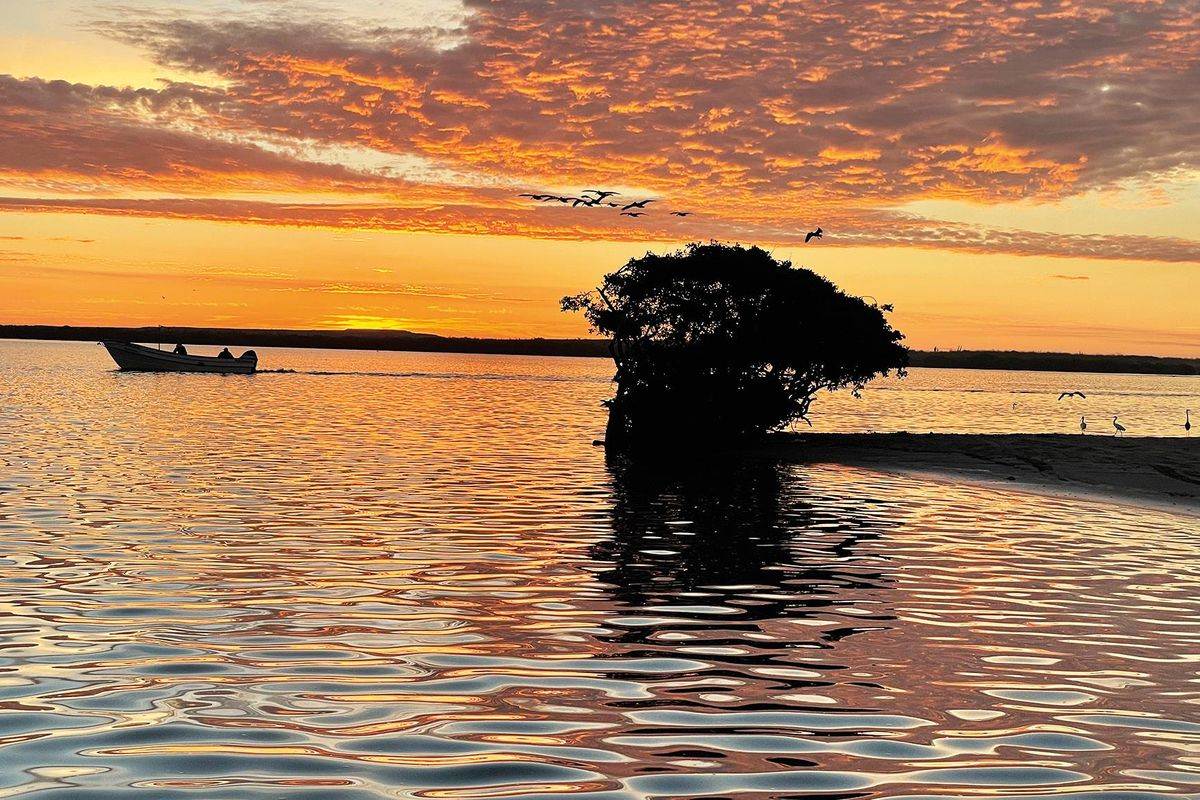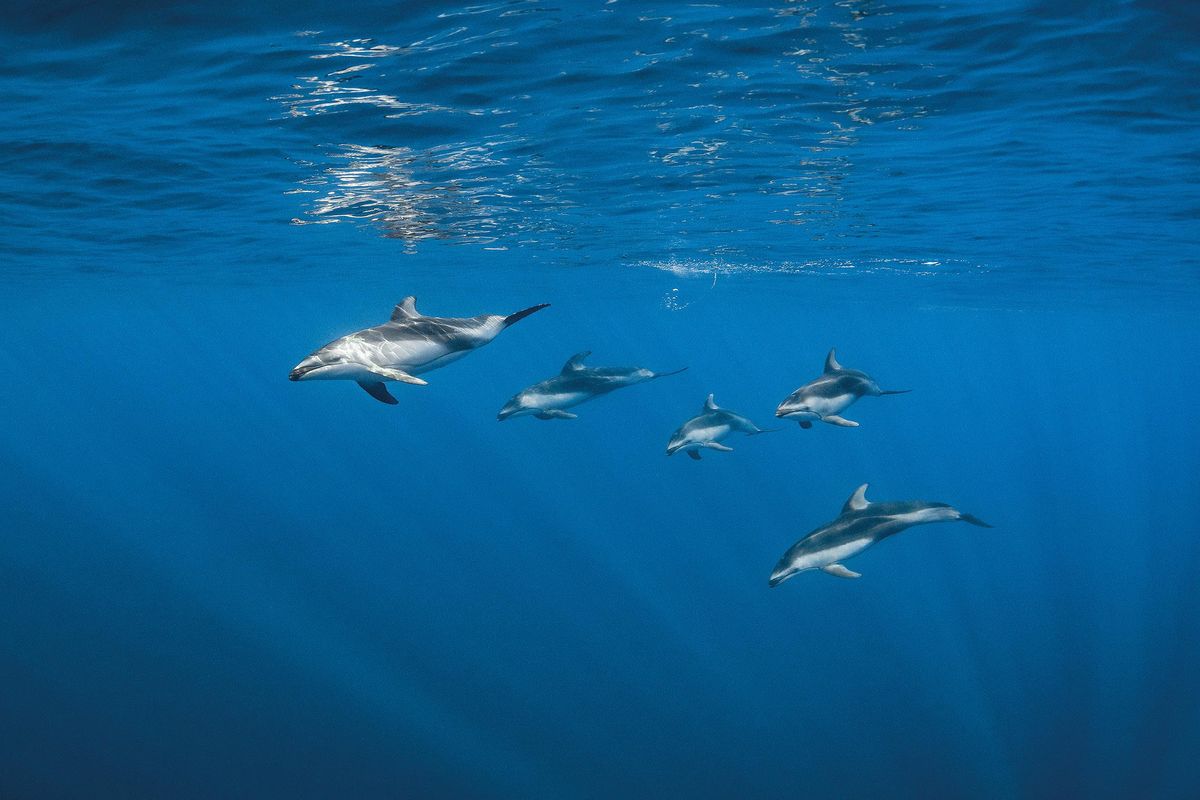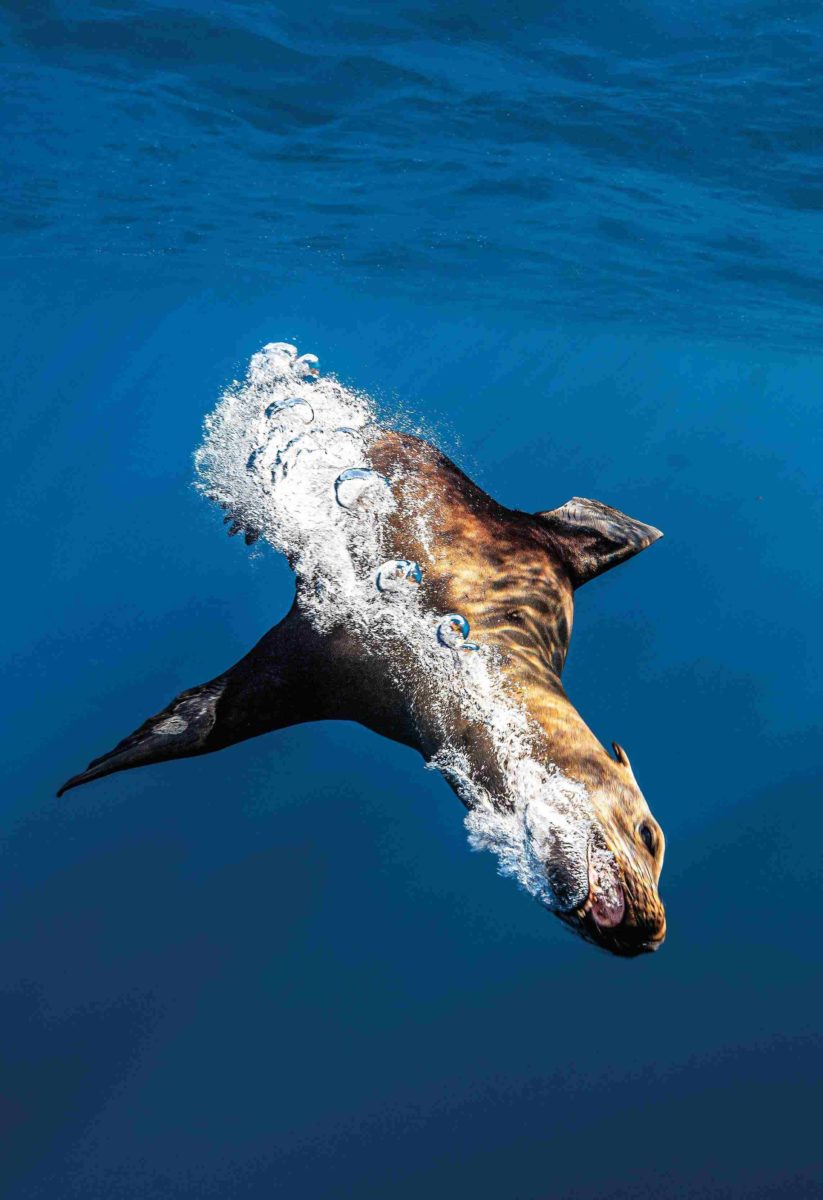
Adrenaline diving chasing bait balls in Magdalena Bay – just watch out for the lethal bills of the marlin
Words and Photographs by Christian Horras
‘Don’t go easy on those fish! Chase them away! Splash on the water, make lots of noise!’ This is not the usual advice you get from your guide during a dive briefing. But a trip out from Magdalena Bay in Baja California in Mexico is not a usual sort of dive.
Why we might want to drive fish away during a dive will become clear later on. First, let’s start at the beginning of our very unusual day. It was early – at around 6 am, we were already sitting in a pick-up truck that would bring us to our boat. It was a short drive to the shore from our guesthouse in the tiny fishing town of Puerto San Carlos. The small boat was mounted on a trailer; as there is no harbour, the boats stay on the trailers during the night.

The boat was launched, we checked over our snorkel equipment, and stored everything in a small compartment at the bow. Having started up the two outboard motors, the captain dug into a small box. With a big, proud smile on his face, he passed our breakfast to us. ‘These are the best sandwiches in Mexico!’ he told us. ‘My wife made them!’
While eating what were remarkably good sandwiches, we headed out of Magdalena Bay to try our luck with some of the best wildlife action the Pacific Ocean has to offer: striped marlin hunting migrating sardines.
Magdalena Bay is located on the west coast of Mexico, a five-hour drive north from the airport of Cabo San Lucas. It is protected from the Pacific Ocean by two sandy barrier islands, Isla Magdalena and Isla Santa Margarita.


From October into November, large schools of sardines gather offshore. Striped marlins herd them into bait balls and drive them to the surface, where they have less chance of escape. Some of the local fishermen have realised that they can generate extra income by providing tours for underwater photographers and divers. They now get paid without having to catch (and kill) the fish, which is good news for everyone concerned.
It’s a 45-minute boat ride to reach the narrow point between the islands that separate Magdalena Bay from the Pacific Ocean. As soon as we arrive, our boat stops and we put on our wetsuits. The action often starts right outside the sheltered bay, so it is better to be ready!
Just as our boat leaves the bay, the Pacific Ocean gives us our first glimpse of what this place has to offer. A few hundred metres away, a humpback whale takes a few breaths at the surface, showing its fluke as it dives down to continue its journey. On the other side of the boat, and a good bit closer, we spot a group of sea lions heading out for the open ocean. Not a bad start.
We begin our search for the bait balls. The local tour operators and fishermen work together, reporting any sightings. After some time, our captain spots the first signs of action and gets us close. To see what is going on in the water is not an easy task. The bait balls move very fast, and they are constantly changing directions trying to shake off the persistent predators. We need to jump in just in front of a bait ball as it is coming towards us, a combination of the right timing and a little bit of luck is needed.
The captain moves the boat into a position where he anticipates the bait ball will pass and our group eagerly waits for the signal to get into the water. With the bait ball changing direction, the captain repositions the boat as fast as he can. ‘Jump! Jump!’ our guide shouts, to drown out the noise of the running boat engines.
Within a fraction of a second, he is in the water. We quickly follow. After hitting the water, I take a quick look around… Nothing. The guide points to the right, and we follow him, finning as fast as we can. But after a few seconds, he stops, and we know we will have to try again.

After several such attempts, we eventually strike lucky. As I jump into the water, a huge school of sardines comes straight at me and rushes past just below our fins. In hot pursuit, just a few metres behind them, are a couple of sea lions accelerating at a dramatic pace. It lasts only a few seconds, but the speed and the intensity of the scene is phenomenal! The sardines have not yet formed a bait ball and are still in a loose formation. At this point, there are no striped marlins to be seen. Nevertheless, we were thrilled and got eager to try again.
Back on the boat, we soon get a radio report from another group on a similar mission which sounds promising. We head for their position.
‘Okay guys, get ready… Jump!’ We hit the water. Nothing. But our guide points straight ahead, and we follow him. After a few seconds of strenuous finning, we see our first bait ball.

The sardines move in a close formation, acting like a single, coherent organism. Not only does the bait ball move as one, but the sardines are also shifting around inside the ball trying to get the best position. A group of sea lions are circling the sardines. They are working as a team, with the group circling tight around the sardines to keep them close together. Then, one after another, the sea lions shoot right through the middle of the bait ball to catch a sardine. As the sea lions control the movement of the bait ball, it is not darting around very much, and we are able to witness the scene for 10 to 15 minutes before getting back into the boat to search for the next encounter.
This time, everyone can see what is happening at the surface. The sea is boiling; desperate sardines are jumping out of the water, sea lions stick their heads out of the ocean to check our boat, and then we spot the distinct fins and spear-like bills of striped marlins cutting through the surface! We jump a few times, and the action is breathtaking! The bait ball is still moving, with rapid changes in direction, but it is no match for the speed of the striped marlins. One by one, they cut through the bait ball with their bills and catch the wounded or dead sardines.
Coming back to the boat for another jump, our guide is excited: ‘We have reports about a static ball!’
Jackpot! This next bait ball is smaller than the previous ones, but it is barely moving, so we don’t have to keep getting back into the boat to chase it. We can stay in the water. For the next 30 minutes, we see up to 15 striped marlins feeding on the sardines. They don’t keep a tight formation in the same way as the sea lions, and back off more after an attack on the bait ball. We watch in awe as one after another of these top predators accelerates to stunning speeds and shoots right through the bait ball, sometimes even jumping out of the water.

After a while, I notice some of the striped marlins passing close, right below us. Until now, they showed no interest in us and ignored our presence. But something has changed. Now they now seem to be checking us out. Suddenly I hear some loud noise on the surface. Our guide is splashing on the water, rapidly swimming between our group. I spot some sardines right below us and instantly recall the advice he gave us during the briefing: ‘Try to chase any fish near you away as quickly as possible!’ As the bait ball is decimated and provides less and less protection, some of the sardines jump ship and seek the protection of any nearby larger animals – us! The marlins are likely to try to clean up the remaining sardines, and we are a bit too close to those spear-like bills. It is time to get back to the boat.
Later on, we make several attempts to get into the water with humpback whales that are migrating south. Unfortunately, it seems we have spent all our luck on the bait balls, and the whales keep diving as soon as we approach. However, from the boat, we do get to see a number of humpback whales breaching!
By now it is late afternoon and time to start on our way back to Puerto San Carlos. We are all thrilled about the intense wildlife action that we experienced. Sometimes mako sharks or killer whales also join the hunt for the sardines. But that will be for another unusual day.



